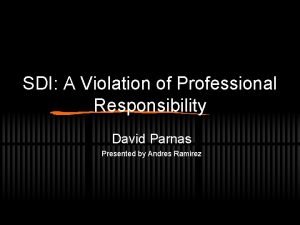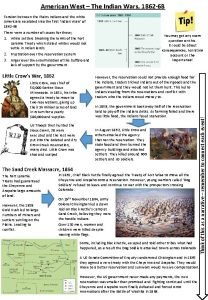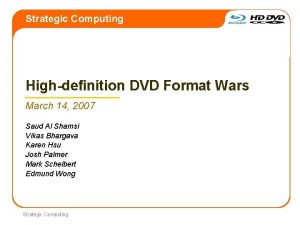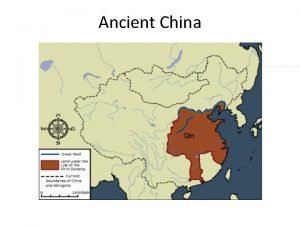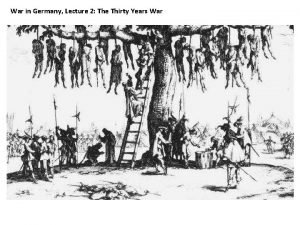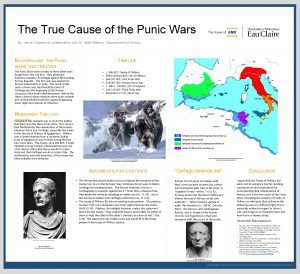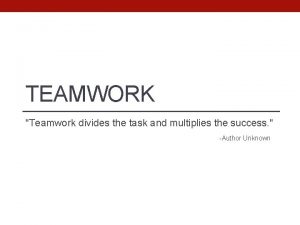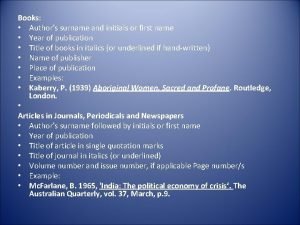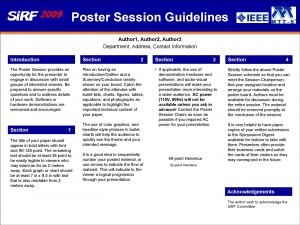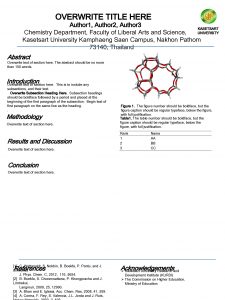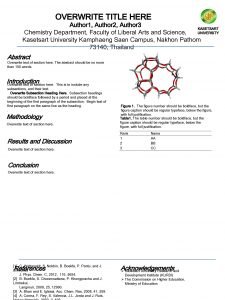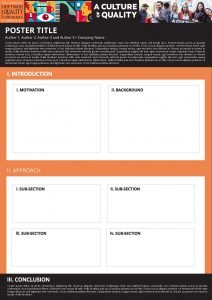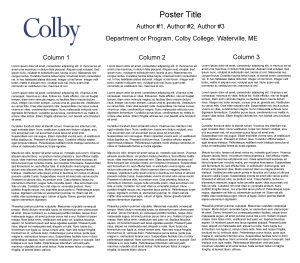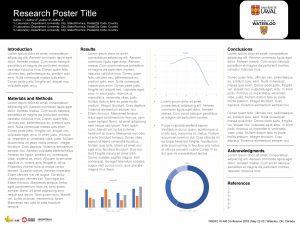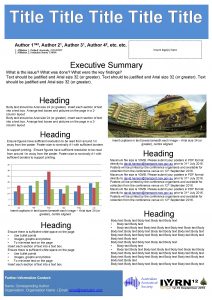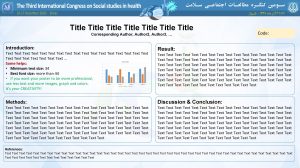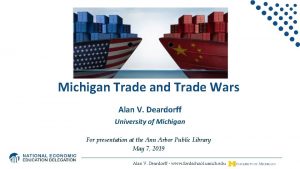U S Trade and Trade Wars Author Ph


















































































































- Slides: 114

U. S. Trade and Trade Wars <Author, Ph. D. > <Affiliation> <Audience> April 30, 2019

National Economic Education Delegation • Vision - One day, the public discussion of policy issues will be grounded in an accurate perception of the underlying economic principles and data. • Mission - NEED unites the skills and knowledge of a vast network of professional economists to promote understanding of the economics of policy issues in the United States. • NEED Presentations - Are nonpartisan and intended to reflect the consensus of the economics profession. 2

Who Are We? • Honorary Board: 47 members - 2 Fed Chairs: Janet Yellen, Ben Bernanke - 6 Chairs Council of Economic Advisers o Furman (D), Rosen (R), Bernanke (R), Yellen (D), Tyson (D), Goolsbee (D) - 3 Nobel Prize Winners o Akerlof, Smith, Maskin • Delegates: 500+ members - At all levels of academia and some in government service All have a Ph. D. in economics Crowdsource slide decks Give presentations • Global Partners: 45 Ph. D. Economists - Aid in slide deck development 3

Where Are We? 4

Credits and Disclaimer • This slide deck was authored by: - Alan Deardorff, University of Michigan - Kadee Russ, University of California-Davis • This slide deck was reviewed by: - Jon Haveman, NEED • Disclaimer - NEED presentations are designed to be nonpartisan. - It is, however, inevitable that the presenter will be asked for and will provide their own views. - Such views are those of the presenter and not necessarily those of the National Economic Education Delegation (NEED). 5

A slowdown in global trade since 2008 IMF 2016 World Economic Outlook, Chapter 2, Figure 2. 1 6

Outline • U. S. Trade • President Trump’s 2018 Trade Actions - Trade War o Solar Panels and Washing Machines o Steel and Aluminum o Cars (threat) o China - Free Trade Agreements o Korea-US Trade Agreement Amended o NAFTA → USMCA 7

U. S. Trade 8

Importance of US Trade • US trade as % of GDP • US trade balance as % of GDP 9

What do we Export? ($1. 6 Trillion) 10

What do we Import? ($2. 4 Trillion) 11

Top US Trade Partners (Goods, 2016) • Top 10 US export destinations NED; 2, 5% FRA; 2, 9% BEL; 2, 4% • Top 10 US import sources IND; 2, 2% ITA; 2, 1% VNM; 2, 0% CAN; 16, 0% KOR; 3, 2% UK; 3, 5% UK; 2, 5% KOR; 3, 3% CHN; 21, 0% GER; 5, 4% GER; 4, 6% JPN; 4, 9% MEX; 14, 0% JPN; 6, 1% CAN; 13, 0% MEX; 14, 0% CHN; 9, 2% 12

U. S. trade • $2. 3 Trillion in exports and $2. 9 Trillion in imports of goods and services in 2017, in total 27% of GDP • Overall, a nearly $570 Billion trade deficit (3% of GDP) • Goods trade deficit over $800 Billion • Services trade surplus about $250 Billion

Bilateral trading relationships

Trade imbalances • Driven by macroeconomic factors - Trade deficits happen when a country’s firms, households, and government together consume more than the country produces. - Trade deficits can happen when a country’s economy starts to expand faster than its trading partners • Example: U. S. -S. K. trade deficit roughly tracks the S. K. -U. S. real GDP growth differential

Trade agreements may re-route trade • Many observers were concerned that the U. S. bilateral trade deficit with South Korea increased more than $10 billion annually after the Korea-U. S. Free Trade Agreement went into force in 2012. • Recent research shows that KORUS just shifted about $13 billion of U. S. imports from other countries to South Korean suppliers (Russ and Swenson). • About half of the re-routed trade was from China.

U. S. now using some established and some new approaches to trade policy Established New • Barriers against import surges and imports of unfairly traded products • Bilateral and multilateral trade agreements to increase market access for U. S. exports • Leadership in GATT/WTO • Non-discrimination • Renegotiations of and withdrawal from existing trade agreements • Weakening of WTO trade dispute settlement mechanism • “Reciprocity”

Recent applications of established barriers against import surges and imports of unfairly traded products • Trade Act of 1974 - Section 201 (surges): solar cells, washing machines - Section 301 (non-market activity): China forced technology transfer • Trade Expansion Act of 1962 - Section 232 (national security): steel and aluminum • Trade Act of 1930 - Anti-dumping and countervailing duties (cover about 80% of steel from China) 18

“What will be the effect of tariffs on the U. S. economy, workers, and households? ” • Consumer impact • Higher costs for US businesses that rely on imported inputs may put these firms and their workers at risk • Risk of recession-- investment is a particularly import-intensive type of demand • Retaliatory tariffs will put firms and jobs in U. S. export industries at risk 19

“What will be the effect of tariffs on the U. S. economy, workers, and households? ” • Consumer impact • Higher costs for US businesses that rely on imported inputs may put these firms and their workers at risk • Risk of recession-- investment is a particularly import-intensive type of demand • Retaliatory tariffs will put firms and jobs in U. S. export industries at risk • “Won’t tariffs start an investment and output boom, since companies that serve the U. S. market will want to produce in the U. S. ? ” • “Won’t tariffs bring back jobs? ” • “Won’t tariffs help raise wages for U. S. workers and reduce inequality? ” 20

Recent Research Suggests Trade Disrupts Job Markets • China Shock 1991 -2011: ≈ 2 million jobs displaced in importcompeting industries (Acemoglu, Autor, Dorn, Hanson, Price) • Impact on some communities absolutely devastating. - Concentrated job losses, home prices fell, cuts to local services, reduced marriage and fertility. • Research suggests that nationally, jobs expanded in other industries by about the same number, or possibly more. - Cheaper imported inputs allow import-using sectors to grow faster. - Feenstra, Ma and Xu; Wang, Wei, Yu, and Zhu 21

22

Trump’s 2018 Trade Actions • Most were tariffs on imports - Taxes levied by US on imports from others - Taxes levied by others (in retaliation) on US exports • Normal effects of tariffs - Raise prices for importers - Lower prices for exporters - Cause substitution To other products o To other countries (if not on all) o ct e f f e c i m o Neett eeccoonnomic yesffect N almost alwa tive is always nega is gative ne Two recent studies of the 2018 Trade War found that exporter prices did not fall. 23

Trump’s 2018 Trade Actions These slides will list only actions actually taken. Most had plans and threats announced in the days and weeks beforehand. 24

Trump’s 2018 Trade Actions • Jan 22, 2018: Safeguard tariffs - 30% on solar panels - 50% on washing machines 25

Safeguards • WTO permits tariffs on imports that cause serious injury • Trump used the following: - 30% on solar panels - 50% on washing machines (both declining over 3 or 4 years) • Both were on exports of all countries - Reason: previous China-only tariffs had been evaded by moving production elsewhere 26

27

Tariffs on Solar Panels • Why? - Increased imports from China had driven US companies out - Anti-dumping duties had failed to help, as companies moved production to other non-China and non-US locations 28

Tariffs on Solar Panels • Who benefits? - Who requested o. Suniva, Chinese owned, manufactures in Georgia and in Saginaw, MI o. Solar. World, was German owned but now French, - 14 US manufacturers, including o. CBS Solar, Copemish, MI 29

30

Tariffs on Solar Panels • Who is hurt? - Consumers - Solar panel installers, led by Solar Energy Industry Association o. They estimate that the 30% tariff “would cause the loss of 23, 000 in 2018, as well as the delay or cancellation of billions of dollars of investments in solar energy. ” 31

32

Tariffs on Washing Machines • Why? - From 2012 to 2016, imports increased dramatically from two Korean firms LG and Sumsung - Anti-dumping duties failed to stop this, as production moved to Thailand Vietnam 33

Tariffs on Washing Machines • Who benefits? - Whirlpool, Benton Harbor, MI, which requested the tariffs o Whirlpool brands include Amana, Maytag, & more - Other US manufacturers, such as GE, Electrolux and Frigidaire (Swedish), Equator, Speed Queen - In 2017, Samsung and LG announced plans to build factories in South Carolina and Tennessee 34

Tariffs on Washing Machines • Who is hurt? - Consumers o Washers (and dryers!) both increased in price by about 12% (per Flaaen et al. 2019) • Note that the tariff was levied on washers only, not dryers] • ”consumers bore between 125 percent and 225 percent of the costs” (NYT 4/21/19) o US appliance prices (I don’t have graph for washing machines alone) rose 8. 1% over the 12 months to Nov 2018 35

Tariffs on Washing Machines Tariff Source: Amiti, Redding, and Weinstein, “The Impact of the 2018 Trade War on U. S. Prices and Welfare, ” CEPR Discussion Paper DP 13564, March 1, 2019. 36

Trump’s 2018 Trade Actions • Jan 22, 2018: Safeguard tariffs • Mar 1, 2018: Announces “nationalsecurity” tariffs on steel and aluminum - 25% on steel, 10% on aluminum - Announced for all countries o Some delayed (EU, Canada Mexico) o Others later exempted (S. Korea) 37

National Security • Trump used Section 232 of US trade law to levy tariffs on imports of metals, based on national security - “Economic security is national security” • (Trump Dec 18, 2017) - 25% on steel, 10% on aluminum - Mar 23: Tariffs start with some exemptions - Mar 28: Korea exemption permanent in return for a quota cutting its exports to ~80% of 2017 - Jun 1: Tariffs extended to EU, Canada, Mexico 38

39

Tariffs on Steel and Aluminum • Responses to metals tariffs - Retaliation by China, EU, Canada, & others - WTO disputes o. May-Aug: Complaints filed AGAINST U. S. o. July: Complaints filed BY U. S. 40

Tariffs on Steel and Aluminum • Who benefits? - US producers of steel and aluminum o. Steel: AISI lists 12 producers in Michigan o. Aluminum: Thomas lists 76 suppliers in Michigan 41

Tariffs on Steel and Aluminum • Who is hurt? - US users of steel and aluminum pay higher prices o. Most obviously the car companies but many others 42

Steel Prices US 25% Tariff 43

Aluminum Price US 10% Tariff 25% 44

45

Source: Kopf (2018) 46

Tariffs on Imported Inputs Can Hurt Firms 47

Trump’s Trade Actions • Jan 22, 2018: Safeguard tariffs • Mar 1, 2018: Announces tariffs on steel and aluminum • May 23, 2018: Initiates Commerce Dept investigation of car and car part imports 48

National Security • Cars - Trump initiated another national security investigation: on imported cars - Trump said he’s considering a 25% tariff on cars and car parts - This would be bigger than on metals: o Tariffs on $48 billion of steel and aluminum imports o Tariffs on $351 billion of car and car part imports (per NYT) 49

50

Tariff on Cars and Car Parts • Who would benefit? - US car companies? o Most (e. g. , GM) are opposed o I can’t find objection from Ford, but others list Ford among those who object - US auto workers? o UAW has spoken in favor of “target measures” with understanding that broad tariffs or quotas “could cause harm” including “mass layoffs for American workers. ” 51

Tariff on Cars and Car Parts • Who would be hurt? - Most car companies, including GM - US car buyers 52

Tariff on Cars and Car Parts Estimated Effects on Car Sales and Prices of 25% Tariff on: Sales impact (units) All imports – 2. 0 M $4, 400 USassembled $2, 270 Canada & Mexico exempted – 1. 2 M 2, 450 1, 135 Source: Center for Automotive Research 53 Average Price Increases ($/unit) on vehicles sold in US All Imported $6, 875 3, 980

Tariff on Cars and Car Parts Estimated Effects on Employment & GDP of 25% Tariff on: All imports Canada & Mexico exempted Source: Center for Automotive Research 54 Total US Employment US GDP – 714. 7 K – 197. 2 K –$59. 2 B – 15. 3 B

Tariff on Cars and Car Parts Estimated Effects of a 25% Tariff on Revenue & Employment in New Car Dealerships Tariff on: All imports Dealership Revenues Total Per D’ship – 66. 5 B – 4. 0 M Dealership Employment Total Per D’ship – 117. 5 K – 7 C & M exempted – 39. 1 B – 50. 5 K Source: Center for Automotive Research 55 – 2. 3 M – 4

Tariff on Cars and Car Parts • Where we stand: - Commerce Dept. sent report to Trump Feb 17 o Not public, but said to include several options for tariffs o Trump has 90 days to decide - FT Jan 22: “president was leaning towards slapping tariffs on automotive imports, in the hope of forcing Brussels to further open the EU market to American farm products. ” 56

Trump’s Trade Actions • Mar 1, 2018: Announces tariffs on steel and aluminum • May 23, 2018: Initiates Commerce Dept investigation of car and car part imports • Jul 6, 2018: First tariffs on China, $34 billion - On $34 billion of China exports to US - Based on unfair trade practices in intellectual property (IP) 57

58

Three Rounds of Tariff Hikes in 2018 59 Source: Congressional Research Service, Enforcing U. S. Trade Laws: Section 301 and China, April 8, 2019

Average U. S. and China Tariffs: Before and After 60 Source: Chad P. Bown, 2019, The 2018 US-China Trade Conflict After 40 Years of Special Protection (PIIE Working Paper 19 -7

61

62

Trump’s Trade Actions • Mar 1, 2018: Announces tariffs on steel and aluminum • May 23, 2018: Initiates Commerce Dept investigation of car and car part imports • Jul 6, 2018: First tariffs on China, $34 billion - On $34 billion of China exports to US - Based on unfair trade practices in intellectual property (IP) 63

China • Concerns about China’s IP practices pre-existed Trump - Theft of technology secrets - Forcing investors in China into joint ventures and sharing technology • Prior to Trump, complaints had been voiced by US and EU, but nothing had been done • US initiated investigation under Section 301 of US trade law (unfair trade practices) - Aug 18, 2017: Investigation initiated - Mar 22, 2018: Report finds unfair trade and recommends tariffs • Since then, Trump has announced and then implemented multiple rounds of tariffs 64

Trump’s Trade Actions • Mar 1, 2018: Announces tariffs on steel and aluminum • May 23, 2018: Initiates Commerce Dept investigation of car and car part imports • Jul 6, 2018: First tariffs on China , $34 billion • Aug 23, 2018: Second tariffs on China, $16 billion • Sep 24, 2018: Third tariffs on China, $200 billion 65

China • This is a “Trade War”: Tariffs and retaliation - US tariffs on $34 billion Jul 6 were matched that day by China tariffs on $34 billion of US exports - US tariffs on $16 billion Aug 23 were matched that day by China tariffs on $16 billion of US exports - US tariffs on $200 billion Sep 24 were less-thanmatched by China on $60 billion of US exports - Trump said he’d use tariffs on still more ($267 billion), approaching all of China’s exports to US o Did not do that; delayed for China-US trade talks 66

China • What’s the point? - To get China to stop its IP practices? - To reduce the US bilateral trade deficit with China? - To stop China’s rise as an economy and as a world power? • Who will “win”? - Nobody! Everybody loses from tariffs - Trump says it’s “easy to win” because he measures success from trade deficit 67

Tariffs 68

Tariffs 69

Makers of Top-20 US-Made Models Sold in China in 2017 Models Ford/Lincoln BMW Mercedes-Benz Jeep Tesla Toyota Chevrolet 5 4 4 3 2 1 1 Cars 44, 487 106, 971 72, 187 15, 831 14, 779 7, 460 977 Source: USA Today from LMC Automotive 70

States Producing Top-20 US-Made Models Sold in China in 2017 Models South Carolina (BMW) Alabama (Mercedes) Michigan (Jeep, Chevy, Ford, Lincoln) Kentucky (Lincoln) California (Tesla) Illinois (Ford; Jeep) Indiana (Toyota) Ohio (Jeep) 4 4 4 2 2 2 1 1 Cars 106, 971 72, 187 21, 873 19, 517 14, 779 14, 603 7, 460 5, 302 Source: USA Today from LMC Automotive + Wikipedia 71

72

Trade War • Effects of the 2018 Trade War - US average tariffs rose, in 6 waves - Prices of imports in US rose - Quantity of imports fell - Number of imported varieties fell Source: Amiti, Redding, and Weinstein, “The Impact of the 2018 Trade War on U. S. Prices and Welfare, ” CEPR Discussion Paper DP 13564, March 1, 2019. 73

Trade War Waves of tariffs: 1 2 Source: Amiti, et al. 2019. 3 4 5 6 74

Trade War Source: Amiti, et al. 2019. 75

Trade War Source: Amiti, et al. 2019. 76

Trade War Source: Amiti, et al. 2019. 77

Trade War • Effects of the 2018 Trade War - Effects varied across US o. US tariffs hit Michigan, hard o. Foreign tariffs did not hit Michigan hard o. Real wages fell most in states other than Michigan Source: Fajgelbaum, Goldberg, Kennedy, and Khandelwal, “The Return to Protectionism, ” March 3, 2019. 78

Trade War Tariff Increase on US Imports Source: Fajgelbaum, et al. 2019. 79

Trade War Tariff Increase on US Exports Source: Fajgelbaum, et al. 2019. 80

Trade War Tradable Real Wage Loss from US Tariffs (without retaliation) Source: Fajgelbaum, et al. 2019. 81

Trade War Tradable Real Wage Loss from Full War Source: Fajgelbaum, et al. 2019. 82

Talks 83

Trade Talks War • China-US Trade Talks, I - Talks began in May 2018, in response to Trump’s threat of tariffs o. China promised to import more from US and allow more foreign investment o. Said to have “averted trade war” o. But then talks broke off in early June - Trade war with China Jul, Aug, Sep 2018 84

Trade Talks War • China-US Trade Talks II - Oct 2018: US and China postured about renewing trade talks - Nov 1, 2018: New round of talks began with phone call from Trump to Xi - Dec 2, 2018: G 20 Summit dinner agrees truce: No more tariffs while talks continue - Talks are still underway, but said to be approaching a deal 85

Trade Talks War • China-US Trade Talks II: Calendar Source: - Nov 9: He & Mnuchin talk by phone Jan 7 -9: Talks in Beijing Jan 30 -31: Talks in DC Feb 11 -15: Talks in Beijing Feb 21 -24: Talks in DC Mar 28 -29: Talks in Beijing Apr 3 -5: Talks in DC Apr 23 -? : Talks in Beijing May 8 -? : Talks in DC 86

Trade Talks War • China-US Trade Talks II: Headlines - Nov 29, WSJ: U. S. , China Exploring Deal to Ease Trade Tensions Dec 4, WSJ: Trump Names Lighthizer to Run U. S. -China Negotiations Dec 30, FT: China and US hail ‘positive progress’ on trade talks Jan 7, WP: Trade talks open in Beijing amid optimism about an end to U. S. -China dispute Jan 9, FT: China and US strike upbeat tone after talks but offer few details Jan 22, FT: US turns down China offer of preparatory trade talks Jan 24, FT: US commerce secretary Ross says US ‘miles’ from a trade deal with China Jan 29, WSJ: Big Divides Remain as U. S. -China Trade Talks Resume Jan 31, FT: Donald Trump says US-China trade talks ‘going well’ Feb 6, WSJ: Agriculture Execs Say U. S. -China Trade Deal Nearing Feb 13, WSJ: China, U. S. Seek Broad Outline of a Trade Pact This Week Feb 15, FT: US-China trade talks end with little sign of progress Feb 16, WSJ: Chinese, U. S. Trade Negotiators Inch Toward a Broad Agreement Feb 21, FT: A potential new snag in the US-China trade talks Feb 23, WSJ: China Trade Talks Extended as Trump Pushes to Close the Deal Feb 28, WSJ: U. S. Drops Threat of 25% Tariffs on Chinese Goods in Sign That Accord Is Near Mar 4, WSJ: U. S. , China Close In on Trade Deal Mar 8, FT: Trump prepared to walk away from ‘bad’ China trade deal Mar 8, NYT: Chinese Officials Becoming Wary of a Quick Trade Deal Mar 18, NYT: Trade Fight With China Enters Overtime, With Tariffs a Costly Sticking Point Mar 28, FT: US-China trade talks could stretch for ‘months’ — Kudlow Apr 3, FT: US and China draw closer to final trade agreement Apr 4, FT: US and China push back timing of possible trade deal Apr 14, NYT: Mnuchin Says China Trade Talks Are Nearing Final Round Apr 26, NYT: Trump Says Xi Jinping of China Will Visit Soon, Stirring Anticipation of a Completed Trade Deal 87

Trade Talks War • China-US Trade Talks II: Headlines - Nov 29, WSJ: U. S. , China Exploring Deal to Ease Trade Tensions Dec 4, WSJ: Trump Names Lighthizer to Run U. S. -China Negotiations Dec 30, FT: China and US hail ‘positive progress’ on trade talks Jan 7, WP: Trade talks open in Beijing amid optimism about an end to U. S. -China dispute Jan 9, FT: China and US strike upbeat tone after talks but offer few details Jan 22, FT: US turns down China offer of preparatory trade talks Jan 24, FT: US commerce secretary Ross says US ‘miles’ from a trade deal with China Jan 29, WSJ: Big Divides Remain as U. S. -China Trade Talks Resume Jan 31, FT: Donald Trump says US-China trade talks ‘going well’ Feb 6, WSJ: Agriculture Execs Say U. S. -China Trade Deal Nearing Feb 13, WSJ: China, U. S. Seek Broad Outline of a Trade Pact This Week Feb 15, FT: US-China trade talks end with little sign of progress Feb 16, WSJ: Chinese, U. S. Trade Negotiators Inch Toward a Broad Agreement Feb 21, FT: A potential new snag in the US-China trade talks Feb 23, WSJ: China Trade Talks Extended as Trump Pushes to Close the Deal Feb 28, WSJ: U. S. Drops Threat of 25% Tariffs on Chinese Goods in Sign That Accord Is Near Mar 4, WSJ: U. S. , China Close In on Trade Deal Mar 8, FT: Trump prepared to walk away from ‘bad’ China trade deal Mar 8, NYT: Chinese Officials Becoming Wary of a Quick Trade Deal Mar 18, NYT: Trade Fight With China Enters Overtime, With Tariffs a Costly Sticking Point Mar 28, FT: US-China trade talks could stretch for ‘months’ — Kudlow Apr 3, FT: US and China draw closer to final trade agreement Apr 4, FT: US and China push back timing of possible trade deal Apr 14, NYT: Mnuchin Says China Trade Talks Are Nearing Final Round Apr 26, NYT: Trump Says Xi Jinping of China Will Visit Soon, Stirring Anticipation of a Completed Trade Deal 88

Accord is near Exploring deal Trade talks Trade Talks War open Closer to • China-US Trade Talks II: Headlines - Feb 21, FT: A potential new snag in the US-China trade talks - Nov 29, WSJ: U. S. , China Exploring Deal to Ease Trade Tensions trade - Feb 23, WSJ: China Trade Talks Extended asfinal Trump Pushes ‘Miles’ from - Dec 4, WSJ: Trump Names Lighthizer to Run U. S. -China Negotiations to Close the Deal - Dec 30, FT: China and US hail ‘positive progress’ on trade talks - Feb 28, WSJ: U. S. Drops Threat of 25% Tariffs on Chinese agreement Goods in Sign That Accord Is Near a trade deal - Jan 7, WP: Trade talks open in Beijing amid optimism about an end to - Mar 4, Talks WSJ: U. S. , China Close In on Trade Deal U. S. -China dispute could - Jan 9, FT: China and US strike upbeat tone after talks but offer few - Mar 8, FT: Trump prepared to walk away from ‘bad’ China trade deal details for. Becoming Wary of a Quick Trade deal - Mar 8, stretch NYT: Chinese Officials - Jan 22, FT: US turns down China offer of preparatory trade talks Trade Deal - Jan 24, FT: US commerce secretary Ross says US ‘miles’ from a trade - Mar 18, NYT: Trade Fight With China Enters Overtime, With ‘months’ deal with China nearing Tariffs a Costly Sticking Point - Jan 29, WSJ: Big Divides Remain as U. S. -China Trade Talks Resume Jan 31, FT: Donald Trump says US-China trade talks ‘going well’ Feb 6, WSJ: Agriculture Execs Say U. S. -China Trade Deal Nearing Feb 13, WSJ: China, U. S. Seek Broad Outline of a Trade Pact This Week - Feb 15, FT: US-China trade talks end with little sign of progress - Feb 16, WSJ: Chinese, U. S. Trade Negotiators Inch Toward a Broad Agreement Little sign of progress - Mar 28, FT: US-China trade talks could stretch for ‘months’ — Kudlow - Apr 3, FT: US and China draw closer to final trade agreement - Apr 4, FT: US and China push back timing of possible trade deal - Apr 14, NYT: Mnuchin Says China Trade Talks Are Nearing Final Round - Apr 26, NYT: Trump Says Xi Jinping of China Will Visit Soon, Stirring Anticipation of a Completed Trade Deal Anticipationof a completed trade deal 89

Trade Talks War • China-US Trade: Issues of Negotiation - Government subsidies to state-owned companies - Chinese purchases of U. S. farm and energy products and services - China’s market-opening efforts in sectors such as financial services and manufacturing - Improving its protection of U. S. intellectual-property rights - Pressure on U. S. companies to share technology - Industrial policies that favor state-controlled companies - Currency stability - Regulatory relief foreign companies in China - How to enforce any agreements on the above o Reimpose tariffs, or o Leave them in place 90

Trade Talks War • What Might a China-US Trade Deal Include? - US wants (per FT, 3/25/19): o Huge Chinese purchases of US exports, to reduce US trade deficit o Liberalization of market access for US goods and services o Reform of Chinese industrial policy, especially “forced transfers” of IP ØUS permitted to use punitive tariffs if these are violated, without China retaliating or complaining to WTO - China wants: o Removal of US tariffs 91

Overview of Trump’s Tariffs Source: James Lake Presentation, April 2019 92

Trade Talks War • Latest News - On Sunday May 4, Trump tweeted that he would o Raise tariffs on Friday from 10% to 25% on the $200 billion from last year o Impose 25% tariffs on the rest of China exports if China does not accept his demands o Reason: China backtracking on promise to reduce subsidies - China’s negotiators are coming to DC anyway 93

Trump’s Trade Actions • Jul 6, 2018: First tariffs on China , $34 billion • Aug 23, 2018: Second tariffs on China, $16 billion • Sep 24, 2018: Third tariffs on China, $200 billion • Sep 24, 2018: Amended KORUS signed - Raises Korea quota for US-certified cars - Extends years of US 25% tariff on light trucks 94

95

Korea • Increased quota for US cars that o Do not meet Korean standards o But do meet US standards - Quota doubles from 25, 000 to 50, 000 cars per auto maker - In fact, US companies have not usually reached the 25, 000 limit 96

Korea • Trucks - Original KORUS had US promise to remove its 25% ”chicken tax” on light trucks from Korea by 2019. - This is now extended to 2041 - This seems important for US makers of pickup trucks, including in Michigan 97

Trump’s Trade Actions • Aug 23, 2018: • Sep 24, 2018: • Sep 30, 2018: Second tariffs on China, $16 billion Third tariffs on China, $200 billion Amended KORUS signed USMCA agreed - NAFTA renegotiation had completed previously with Mexico - Now Canada signed on, and name changed (by Trump) to USMCA - USMCA: U. S. -Mexico-Canada Trade Agreement 98

99

NAFTA → USMCA • NAFTA is - Free Trade Agreement (FTA) o Zero tariffs on goods traded by US, Canada, Mexico o Only if they satisfy Rules of Origin (ROOs) - Additional provisions regarding many things o Services trade o Foreign direct investment o Intellectual property rights o Dispute settlement o Government procurement 100

NAFTA → USMCA • USMCA will be (if approved) - FTA with stricter ROOs - Some changes in NAFTA’s additional provisions - New rules for environment, labor, financial services, digital trade - Weakening of Canada’s dairy barriers - Discouragement of trade with China - Provision for renegotiation (sunset) 101

NAFTA → USMCA • Most important for Michigan: Tighter ROOs for cars and car parts - North American content increased from 62. 5% to 75% o Intended to reduce inputs from outside N. America, likely benefiting Mexico - New requirement that 40 -45% of content must be from labor paid $16/hr or more (but does not rise with inflation) o Intended to reduce inputs from low-wage Mexico, benefiting US and Canada 102

NAFTA → USMCA • Effects of tighter ROOs - If ROOs are o Satisfied: Higher costs of production o Not satisfied: Tariffs on traded inputs and final products - Either way o Prices rise o Demand falls o Products become less competitive internationally - Effects on demands for labor ambiguous throughout 103

NAFTA → USMCA • Will USMCA be ratified? - Needs ratification in all three countries - In US, there are problems o Democrats want changes • Stronger enforcement of labor provisions • Remove tariffs on steel and aluminum o Approval requires a report from USITC, delayed by government shutdown, but was issued Apr 18 - Trump threatens to issue six-month withdrawal notice from NAFTA 104

NAFTA → USMCA • USITC Report Main Findings - Positive impact on US real GDP and employment o Raise GDP by 0. 35% o Raise employment by 0. 12 % - Most significant effects from o Reduced uncertainty in digital trade o Rules of origin in auto sector - Auto sector o Increase in US production o Small increase in prices and reduced demand 105

NAFTA → USMCA • News from Michigan - April 24, MLive: 106

107

Conclusion • Trump’s trade actions in 2018 - Raise prices to consumers - Raise costs to producers - Alienate other countries 108

Agreement on Incidence 109

Likely to Impact Low Income Groups Heavily 110

Conclusion • May they serve any purpose? - Not to reduce trade deficit(s) o. Tariffs may reduce both exports and imports o. They do not change overall trade balance o. Mar 6, 2019, NYT: • “The United States trade deficit in goods ballooned to its largest level in history, reaching $891. 3 billion in 2018, despite President Trump’s repeated promise to reduce that figure. ” 111

Conclusion • May they serve any purpose? - Perhaps to motivate other countries to change policies for the better o. US is negotiating with • China, to change their IP policies and increase imports from US • EU and Japan to open to more imports of agricultural goods from US 112

Risks from all-out trade war • Moody’s Mark Zandi estimated an all-out trade war would cost 4 million U. S. jobs. • Observed import share in U. S. consumption deceptively low due to unobserved competitive effects of rival suppliers. • Across-the-board increase in tariffs may fall heavily on the poor and families with children (Furman, Russ, and Shambaugh; USITC). Source: Furman, Russ, and Shambaugh

Thank you! Any Questions? www. NEEDelegation. org Kadee Russ, Ph. D. KNRuss@UCDavis. edu Contact NEED: Info@NEEDelegation. org Submit a testimonial: www. NEEDelegation. org/testimonials. php 114
 First author second author third author
First author second author third author Trade diversion and trade creation
Trade diversion and trade creation Trade diversion and trade creation
Trade diversion and trade creation Trade diversion and trade creation
Trade diversion and trade creation Trade diversion and trade creation
Trade diversion and trade creation Tramp shipping and liner shipping
Tramp shipping and liner shipping Who fought in the punic wars?
Who fought in the punic wars? Romans vs carthaginians
Romans vs carthaginians Opium wars and boxer rebellion
Opium wars and boxer rebellion Committees of correspondence
Committees of correspondence The rise of napoleon and the napoleonic wars
The rise of napoleon and the napoleonic wars Artilarist
Artilarist Star wars and greek mythology
Star wars and greek mythology What was the main cause of the punic wars?
What was the main cause of the punic wars? Persian and peloponnesian wars
Persian and peloponnesian wars Wars revolutions and reforms
Wars revolutions and reforms The trade in the trade-to-gdp ratio
The trade in the trade-to-gdp ratio Fair trade not free trade
Fair trade not free trade What was the triangular trade
What was the triangular trade How did darius i change persia's political organization
How did darius i change persia's political organization Unit 7 the world between the wars
Unit 7 the world between the wars To lucasta, going to the wars
To lucasta, going to the wars Timeline of the persian wars
Timeline of the persian wars The war to end all wars
The war to end all wars Who fought in the punic wars?
Who fought in the punic wars? Persian war map
Persian war map The defining moment in greek history is the
The defining moment in greek history is the The war to end all wars worksheet
The war to end all wars worksheet Cortina wars
Cortina wars Important events in the 80s
Important events in the 80s Star wars brain break
Star wars brain break Galactic empire vs combine
Galactic empire vs combine A group of 82 students were surveyed
A group of 82 students were surveyed Math wars 2
Math wars 2 Persian wars timeline
Persian wars timeline Displaywars
Displaywars Cola wars continue
Cola wars continue Daniel williams bride wars
Daniel williams bride wars Blue gold world water wars summary
Blue gold world water wars summary Star wars fat monster
Star wars fat monster Chapter 24 the west between the wars
Chapter 24 the west between the wars Opium wars defintion
Opium wars defintion English civil war timeline
English civil war timeline Star wars taoism
Star wars taoism Dane star wars
Dane star wars Sled wars
Sled wars What is a flamewar
What is a flamewar David parnas
David parnas Define persian wars
Define persian wars Archetypes in star wars
Archetypes in star wars Indirect and direct control imperialism
Indirect and direct control imperialism Wars i sawa plan wydarzeń
Wars i sawa plan wydarzeń The indian wars 1862-68
The indian wars 1862-68 Ides of march punic wars
Ides of march punic wars The art of standards wars
The art of standards wars Format wars examples
Format wars examples Ballplayer with three-part yoke and bird headdress
Ballplayer with three-part yoke and bird headdress The punic wars worksheet answer key
The punic wars worksheet answer key Napoleon bonaparte achievements timeline
Napoleon bonaparte achievements timeline Guild wars 2 elementalist
Guild wars 2 elementalist Europe in crisis the wars of religion
Europe in crisis the wars of religion Punic wars tiberius
Punic wars tiberius Effects of first carnatic war
Effects of first carnatic war Persian wars definition
Persian wars definition The carnatic wars were a series of
The carnatic wars were a series of Zhou dynasty wars
Zhou dynasty wars On the eve of world war i, bosnia was ruled by... *
On the eve of world war i, bosnia was ruled by... * Habsburg-valois wars
Habsburg-valois wars Habsburg-valois wars
Habsburg-valois wars Voice wars
Voice wars French wars of religion summary
French wars of religion summary Causes of the punic wars
Causes of the punic wars French wars of religion summary
French wars of religion summary Cold war proxy
Cold war proxy Tar wars
Tar wars Star wars combine
Star wars combine Star wars gansta rap
Star wars gansta rap The art of standards wars
The art of standards wars Rome after the punic wars
Rome after the punic wars Effects of the punic wars
Effects of the punic wars Causes of the punic wars
Causes of the punic wars Persian wars
Persian wars China karanasan sa digmaang pandaigdig
China karanasan sa digmaang pandaigdig Wars involving us
Wars involving us What are the three basic teachings of hinduism
What are the three basic teachings of hinduism Price wars examples
Price wars examples In the punic wars rome fought against
In the punic wars rome fought against What were the causes and effects of the persian war
What were the causes and effects of the persian war Punic wars def
Punic wars def Punic wars notes
Punic wars notes Third anglo-powhatan war
Third anglo-powhatan war Czy wars i sawa to postacie fantastyczne
Czy wars i sawa to postacie fantastyczne Holy wars key
Holy wars key Strtoupper star wars
Strtoupper star wars Whale wars intro
Whale wars intro Frontier apush
Frontier apush Brainpop seminole wars
Brainpop seminole wars How many wars did louis xiv wage between 1667-1713
How many wars did louis xiv wage between 1667-1713 Moroccan crisis ap euro
Moroccan crisis ap euro What is the mood in the devil and tom walker
What is the mood in the devil and tom walker Awake united states!
Awake united states! Teamwork divides the task and multiplies the success author
Teamwork divides the task and multiplies the success author What is literary criticism
What is literary criticism James and the giant peach author
James and the giant peach author Characterization is the way an author
Characterization is the way an author First name and last name example
First name and last name example What is the tone of a story
What is the tone of a story Title page apa format
Title page apa format Title and affiliation
Title and affiliation Name of affiliation
Name of affiliation Rhetorical precis template
Rhetorical precis template Authors attitude
Authors attitude Title and author
Title and author Nostalgic tone
Nostalgic tone What is characterization ?
What is characterization ?















































